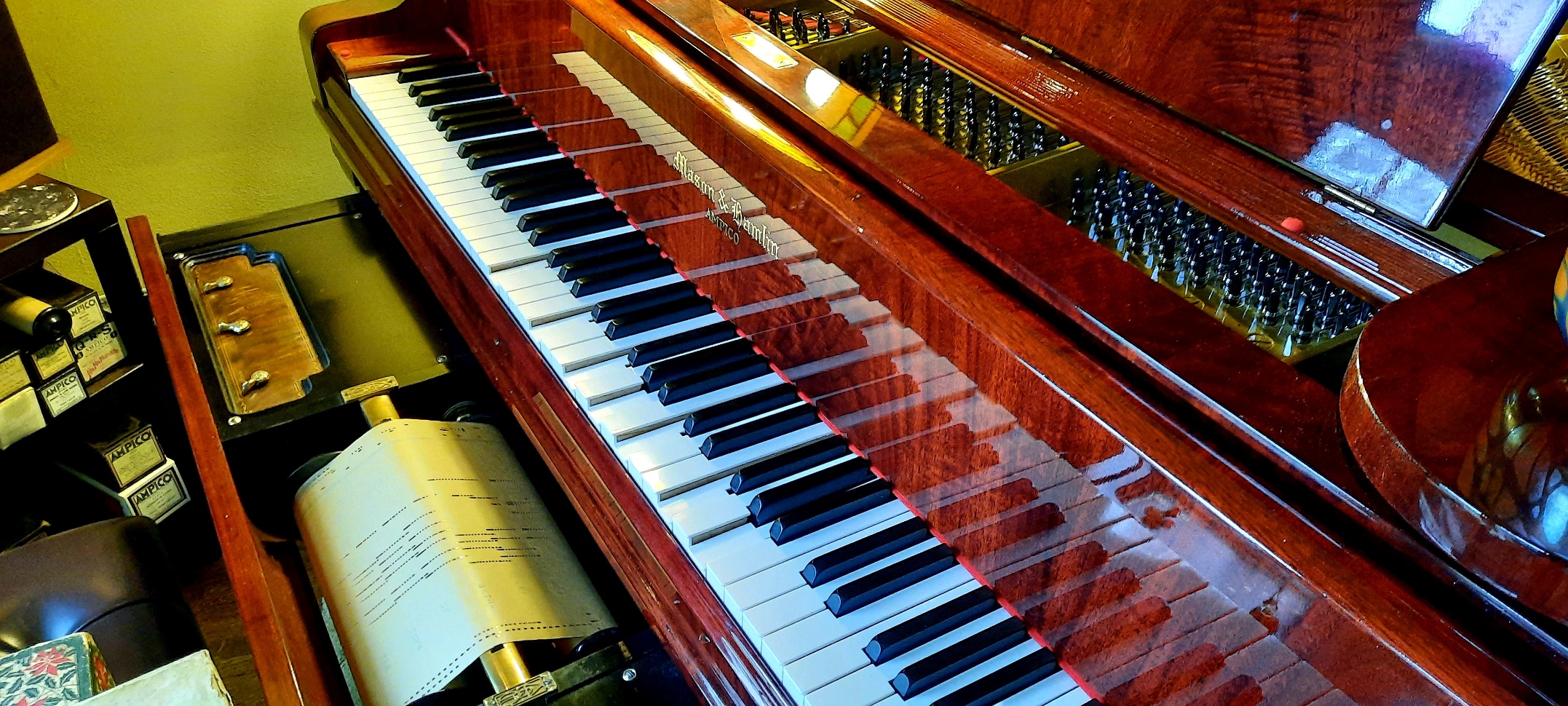Over a century ago, famous artists played on specialized instruments from Ampico designed to capture their work. Today, you can download those very same performances as MIDI files available for download! Your very own Disklavier can reproduce those century-old performances. What once were marks made by a nearly-extinct technology on chemical paper can now be music digitally reproduced in your living room!
This is a very interesting technology, and so I spent a bit of time researching it. A client and I were recently discussing where these recordings came from and how they were made. I thought I’d share what we found!
If you download a song prepared on an Ampico from one of these public domain MIDI archives, here’s what you can imagine having happened!
The History of Ampico Pneumatic Reproducing Pianos
Ampico recordings were created using specialized recording pianos designed to capture a pianist’s performance. The technology of recording developed alongside the pneumatic player pianos themselves.
Early designs by Charles Stoddard, dating back to 1908, employed electrical contacts attached to each piano key or hammer. These contacts would complete circuits during key presses, marking note events onto a moving paper roll. The length of these marks corresponded to the duration of each note played.
The American Piano Company introduced the public to the Ampico in 1912. By 1914, these instruments were more commonplace. Although remarkable for its time, it wasn’t using the piano-forte to its full potential. It played everything at one volume: It was really just a forte!
Introducing Dynamics
Accurately replicating a pianist’s touch is one of the most challenging parts of player piano design. We really didn’t succeed until the modern digital player piano area and, in particular, the Disklavier. However, the Ampico was an early attempt, and it did remarkably well for its time.
By 1925, Ampico introduced a more advanced recording apparatus developed by engineer Clarence Hickman. This system utilized a “spark chronograph,” which measured the hammer velocity with high precision by recording electrical sparks onto chemically treated paper. This method allowed for the accurate capture of the intensity of each note, reflecting the pianist’s touch and dynamic expression. In this sense, it was the forebear of the modern digital piano.
Despite these technological advancements, the dynamic information recorded often required manual interpretation and editing. Ampico employed a team of musical editors who would analyze the recorded data and adjust the dynamic coding. They ensured that the reproducing piano could faithfully recreate the original performance’s expressive nuances.
These meticulously crafted recordings were then transferred onto perforated paper rolls, which, when played on Ampico reproducing pianos, allowed listeners to experience performances with remarkable fidelity to the original artist’s interpretation.
The Modern Era
You’re probably not reproducing these on a pneumatic player piano or an original Ampico. Using specialized piano roll scanners, various technicians, historians, and enthusiasts have scanned those old rolls. You can convert a roll into a MIDI file by taking the various holes and marks, and converting them into the appropriate note-on and note-off events. The cleaned up data can then be exported to a MIDI file. You can then take that file on play it on your own digital player piano today!
For a visual demonstration of how the Ampico reproducing piano operates, you might find the following video informative:
Current Roll Scanning Projects
Stanford University Piano Roll Archive (SUPRA)
Stanford University has undertaken a project to digitize their extensive collection of historical piano rolls, including Ampico rolls. The archive provides access to sample scans of various roll types from the Stanford Library collections. These include the actual, graphic scans of the rolls, which is interesting and fun to look at !
Terry Smythe’s Piano Roll Scanning Initiative
Terry Smythe developed a specialized piano roll scanner aimed at digitizing and converting piano rolls into MIDI files. His work has been instrumental in preserving numerous performances originally recorded on Ampico rolls. It’s worth clicking on this just to see his scanner, which is incredibly neat.
AMMILAB’s Piano Roll Scanner 2.0
The Italian Mechanical Music Association (AMMI) has developed the “Piano Roll Scanner 2.0,” a system designed to scan and convert piano rolls into digital formats. This project focuses on preserving mechanical music by digitizing various types of perforated music storage media, including Ampico rolls.
Spencer’s E-Rolls Custom Scanning
Spencer’s E-Rolls offers custom scanning services for reproducing piano rolls, with an emphasis on Duo-Art, Ampico, and Welte libraries. Utilizing gentle scanning equipment, they ensure the preservation of fragile rolls while converting them into digital formats.
Sources
Pianola.org on the Reproducing Piano
Interlude’s Listening to the Past without A Record Player
Mechanical Music Digest’s A Spark Chronograph Developed For Measuring Intensity Of Percussion Instrument Tones.
Player-Care.com’s How Does the Ampico Rate?
